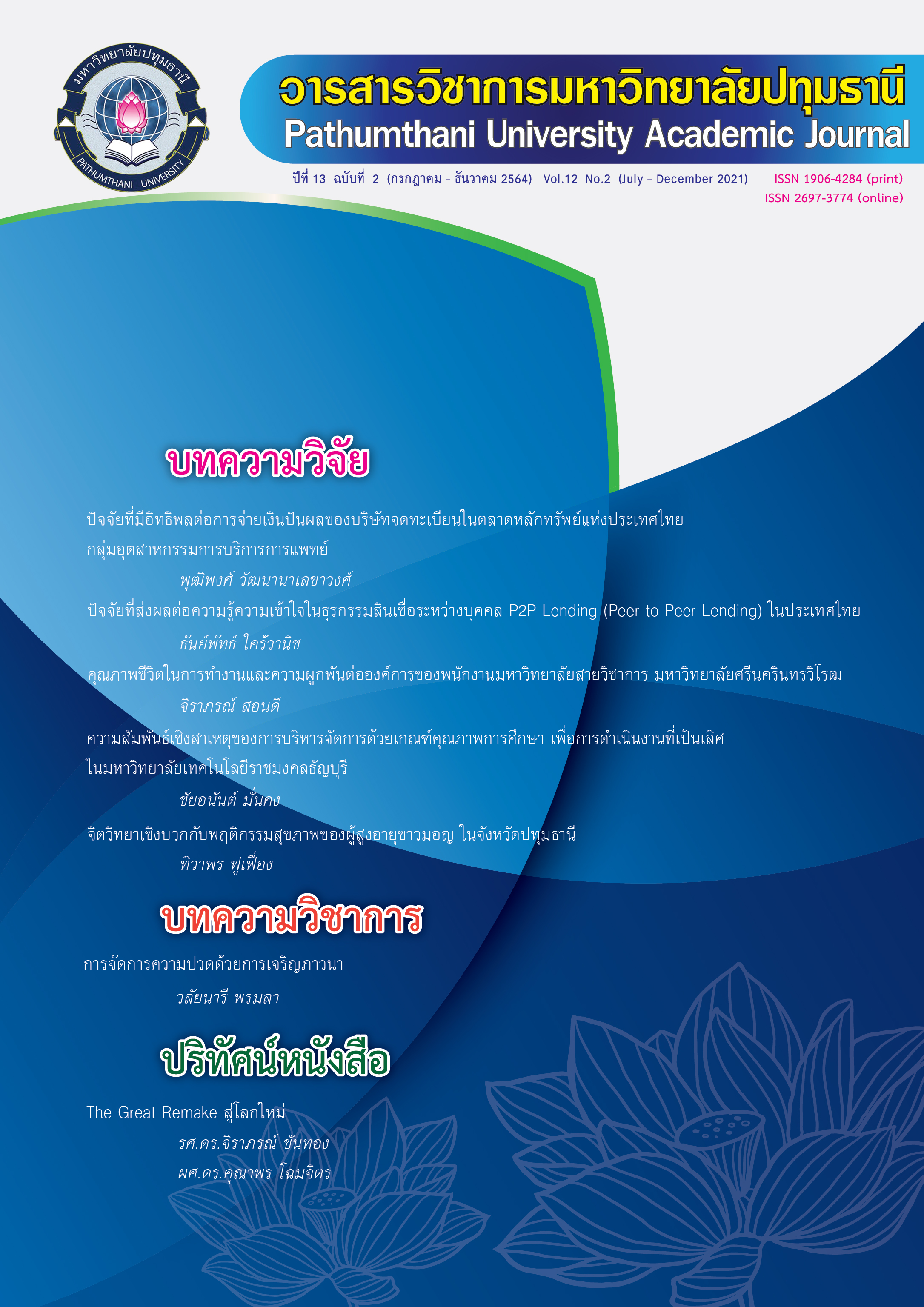The LEARNING ACHIEVEMENT DEVELOPMENT USING SIMPSON’S INSTRUCTIONAL MODEL: FARMER’S DANCE
Keywords:
Learning achievement, Farmers' Dance, Simpson's teaching modelAbstract
This research aimed to compare 1) the learning achievement of the experimental group of Secondary 3 (Grade 9) students of Nawaminthrachinuthit Horwang Nonthaburi School in the dramatic arts course named "Farmers’ Dance" before and after using Simpson's teaching model, and 2) the learning achievement in skills of Secondary 3 (Grade 9) students of Nawaminthrachinuthit Horwang Nonthaburi School in the dramatic arts course named "Farmers’ Dance" between the experimental group – using Simpson's teaching model and the control group – using traditional teaching method. The samples consisted of 64 Secondary 3 (Grade 9) students from two classes of Nawaminthrachinuthit Horwang Nonthaburi School in the 2nd semester, academic year 2020. The students were divided into the experimental group including 32 students and the control group including 32 students. The research instruments were 6 Farmers' Dance lesson plans based on Simpson’s teaching model, 20-item multiple choice tests, and skill assessment forms. The data were analyzed using frequency distribution, mean, standard deviation, and the comparative statistics comprised Dependent Samples t - test and Independent Samples t - test.
The research results revealed that: 1) the learning achievement of the experimental group in the dramatic arts course named "Farmers’ Dance" after using Simpson's teaching model was higher than before learning at the significance level of .05. 2) The learning achievement in skills of the experimental group, using Simpson’s teaching model, was higher than the control group, using traditional teaching method at the significance level of .05.
References
กระทรวงศึกษาธิการ. (2551). หลักสูตรแกนกลางขั้นพื้นฐาน พุทธศักราช 2551. กรุงเทพมหานคร : โรงพิมพ์ชุมชนสหกรณ์การเกษตรแห่งประเทศไทย.
กฤตมุข ไชยศิริ. (2559). การพัฒนาชุดการสอนโดยใช้รูปแบบการสอนทักษะปฏิบัติของซิมพ์ซัน เรื่องการร้อยลูกปัดวิชาการงานอาชีพและเทคโนยี สำหรับนักเรียนชั้นประถมศึกษาปีที่ 5 โรงเรียนวัดอ่างแก้ว (จีบ ปานขำ). การศึกษาค้นคว้าอิสระปริญญาศึกษาศาสตรมหาบัณฑิต. มหาวิทยาลัยศิลปากร.
จุฑารัตน์ ดวงเทียน. (2558). การพัฒนาแผนการจัดการเรียนรู้โดยใช้ทักษะปฏิบัติของซิมพ์ซันร่วมกับการเรียนรู้แบบร่วมมือ เทคนิค STAD เรื่องการประดิษฐ์ท่ารำประกอบเพลงค่านิยม 12 ประการสำหรับนักเรียนชั้นมัธยมศึกษาปีที่ 3. วิทยานิพนธ์ปริญญาศึกษาศาสตรมหาบัณฑิต สาขาวิชาวิจัยและพัฒนาหลักสูตร. มหาวิทยาลัยเทคโนโลยีราชมงคลธัญบุรี.
จำเนียร หาญชัยภูมิ. (2554). การร้อยลูกปัด กลุ่มสาระการเรียนรู้ศิลปะ สำหรับนักเรียนชั้นประถมศึกษาปีที่ 4 โดยใช้รูปแบบการเรียนการสอนตามแนวคิดพัฒนาทักษะปฏิบัติของซิมพ์ซัน. วิทยานิพนธ์ปริญญาครุศาสตร์มหาบัณฑิต. มหาวิทยาลัยราชภัฏเทพสตรี.
ทิศนา แขมณี (2545). ศาสตร์การสอน. กรุงเทพมหานคร : จุฬาลงกรณ์มหาวิทยาลัย.
นิสา เมลานนท์. (2555). พัฒนานวัตกรรมการสอนวิชานาศิลป์ เรื่อง นาฏลีลานาฏยศัพท์ โดยใช้วิธีสอนปฏิบัตินาฏศิลป์ตามแนวคิดการพัฒนาทักษะปฏิบัติของซิมพ์ซัน (Symson). ฉะเชิงเทรา: คณะมนุษย์ศาสตร์และสังคมศาสตร์ สถาบันราชภัฏราชนครินทร์.
รจนา สุนทรานนท์ และ คำรณ สุนทรานนท์. (2556). เกณฑ์มาตรฐานวิชาชีพนาฏศิลป์ไทย ระดับการศึกษาขั้นพื้นฐาน. มหาวิทยาลัยเทคโนโลยีราชมงคลธัญบุรี.
เสาวลี ภูบาลชื่น. (2556). การพัฒนากิจกรรมการเรียนรู้สาระนาฏศิลป์ เรื่อง รำวงมาตรฐาน ชั้นประถมศึกษาปีที่ 4 โรงเรียนสาธิตมหาวิทยาลัยมหาสารคาม(ฝ่ายประถม) ตามแนวคิดของซิมพ์ซัน. การศึกษาค้นคว้าอิสระปริญญาการศึกษามหาบัณฑิต สาขาวิชา หลักสูตรและการสอน. มหาวิทยาลัยมหาสารคาม.
Downloads
Published
How to Cite
Issue
Section
License
บทความที่ได้รับการตีพิมพ์เป็นลิขสิทธิ์ของวารสารมหาวิทยาลัยปทุมธานี
ข้อความที่ปรากฎในบทความแต่ละเรื่อง เป็นความคิดเห็นส่วนตัวของผู้เขียน กองบรรณาธิการไม่จำเป็นต้องเห็นด้วยเสมอไป และไม่มีส่วนรับผิดชอบใด ๆ ถือเป็นความรับผิดชอบของผู้เขียนแต่เพียงผู้เดียว



